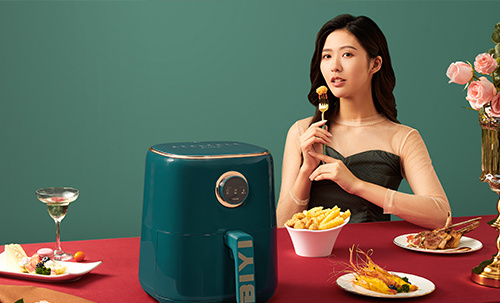Introduction
"Home Economy" Boosts Explosive Growth of Air Fryers Will It Become a Just-Needed Product?
The air fryer is preheated at 180 ° for 5 minutes, and the marinated chicken wings are discharged into the frying basket. The timing is about 15 minutes, and the temperature is adjusted to 180 °. The middle part only needs to be turned over once, and a plate of fried chicken wings with tender outside and inside is finished." Xiaomei, who can't cook, also practiced cooking skills during the epidemic. Relying on the air fryer, she has already eaten French fries, fried sweet potatoes, fried chicken wings, fried mushrooms and other delicacies. "Now outside restaurants don't open, want to eat the basic is very difficult to eat. In addition to like the feeling of eating their own food, the reason why I chose to buy an air fryer is mainly to watch the food live, feel good to start", Xiaomei shared with us her "learning to cook" experience.
Xiaomei is not an example. There are many consumers like her. With the help of the "home economy", the air fryer is growing explosively. According to Suning's big data, among kitchen appliances, electric ovens increased by 280 and air fryers increased by 659.
Air fryers have grown against the trend and become "net red" products. In addition to product characteristics such as "simplicity and convenience", consumer demand and live delivery have also played a role in boosting. Will the air fryer become a just-needed product? Or is it just a coping product. To explore this problem, we have to start with the product itself.
The working principle of the air fryer is mainly through the process of continuous hot air circulation in the closed pot, so that the hot air takes away the moisture on the surface of the food, so that the food has a crisp taste. At the 2010 IFA International Consumer Electronics Show, Philips launched the first air fryer, followed by brands such as Joyoung and Supor. Because the main selling point of "oil-free health" is in line with consumers' demand for health products, it has also been popular in the consumer market. So many years have passed, why has it been tepid after the fire has only recently entered people's field of vision?
This is still from the "oil-free health. Although it is labeled as "oil-free and healthy", the air fryer still needs a small amount of oil when working, such as chicken breast, hairtail and other less oil or oil-free ingredients. It is difficult to achieve the effect of "frying" without adding oil. In addition, high-temperature work will cause the loss of food nutrients. What is more dangerous is that starch and oil in food may produce carcinogens such as acrylamide, heterocyclic amines, and benzopyrene at a high temperature of 120 degrees, which will affect human health.
According to a survey from South Korea in December 2019, 4 of the 10 air fryers on the market have exceeded the standard of acrylamide, the most serious one has exceeded the standard by more than twice. It seems that it is not without reason that our elders often advise us to eat less fried food, including food fried in an air fryer.
Another reason is the taste of food, noise. Many netizens who have used the air fryer commented on the Internet, "The air fryer is not as good as expected. Compared with the oven food, the cooked food is still a little less meaningful. It may be because the wind takes away some moisture and makes the food taste very firey." "The air fryer is too noisy when working, just like a hair dryer at the maximum position in a barber shop, and it rings for half an hour, it affects the mood".
Of course, the air fryer has been tepid after the fire has also been affected by market factors. On the one hand, air fryers are not the only way to bake food, as can alternatives such as ovens and steaming ovens; on the other hand, the overall performance of the industry is uneven, with small brands of air fryers in the majority, and the quality is not guaranteed. It also affects the reputation of air fryers.
Generally speaking, the air fryer is a small category among many kitchen and electrical products, and there is no rigid demand as shown by the current range hood. Whether it will become a rigid demand product remains to be verified by the market.











